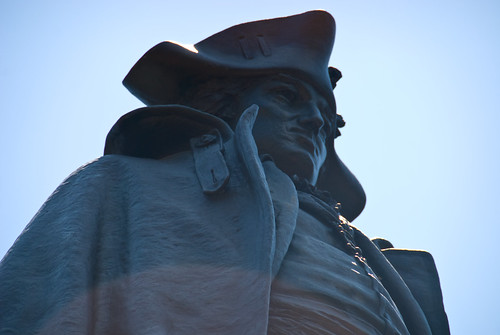The statute memorializing America’s first drill sergeant sits in the northwest corner of President’s Park, as the area immediately north of the White House is commonly know. [fixed, thanks Kate!] Lafayette Park, as the north end of President’s Park above the White House is commonly known. Of course, most of us know it most commonly as the place the whackos highly dedicated stand outside in punishing weather to make their statements about our government’s choices. That’s assuming, of course, that we think of it at all as we use it as a byway between 17th and 15th street on our way somewhere else.
Ol’ Freddie sits far away from where the protesters and tourists would get a chance to see him, and that’s a shame on many levels. First and foremost, the North end of President’s Park is shady and green in the summer, a welcome change from the stark and open concrete expanse in front of the White House where the tourists pose. I took my shots there on a day when I walked down from Dupont along Connecticut Avenue and on to the Smithsonian, and my pass through the park was a nice shady respite from the hot July day.
This shot faces south towards the White House, just off to the side of the monument.
Beyond that aesthetic aspect, however, is the fact that von Steuben was arguably pivotal in America’s success in staying independent after declaring itself to be a sovereign nation.
You can’t help but wonder if the tradition of “YES, DRILL SERGEANT” is a result of not having the time to say “YES Friedrich Wilhelm Ludolf Gerhard Augustin von Steuben!” von Steuben’s full name is a mouthful, and I hope you’ll forgive me for shortening it going forward. There’s a certain sad irony in his story – over two hundred years later, we’re still arguing about when it’s okay to deny people employment because they’re homosexual. The only reason we had the chance to work with von Steuben, however, is because unconfirmed rumors of his sexuality got him drubbed out of his job in Germany. Once he came into the new United States’ employ he put in place training and assignment systems that allowed us to beat the Brittish. He’s also credited with introducing bayonet training to the new American army, a fighting method whose silence allowed the troops to execute at least one sneak attack and victory in a fight at Stony Point, a fortification with superior arms that couldn’t have been taken by overt force.
von Steuben’s accomplishments yielded him several statues in other locations, a rather large tomb in his retirement home of New York, and a big old parade. Contrary to what you might have seen of the parade in the movies, Matthew Broderick and the music of the Beatles are not normally included.
Our particular statute was made by Albert Jaegers, who seems to for a time to have made at least a mini-mission of it. Jaegers is also behind the statue in Philly, and a duplicate of the one that sits in President’s Park was presented to Kaiser Wilhelm II and the nation of Germany in 1911 – one of the last large metal gifts we’d present to that country from ground level for quite a while.
Germany’s copy is only the top piece of the monument, at least as it survives and is displayed today. In President’s Park the monument is flanked on both sides by other sculptures. Below him to the left a young boy seems to sit at his mother’s knee, while off the the right a young man stands, sword in hand, above a centurion. Lacking anyone else’s analysis I assume this represents a young American army coming of age and being turned from children into soldiers through the teachings of von Steuben.
Some references I consulted: http://www.goethe.de/ins/us/was/pro/vtour/dc2/future/steuben/en_index.htm, http://www.goethe.de/ins/us/was/pro/vtour/dc2/future/steuben/en_tmb2.htm, http://commons.wikimedia.org/wiki/Image:Baron_von_Steuben.jpg, http://en.wikipedia.org/wiki/President%27s_Park, http://en.wikipedia.org/wiki/Friedrich_Wilhelm_von_Steuben, http://commons.wikimedia.org/wiki/Category:Albert_Jaegers



Huh. I thought the area directly north of the White House was commonly known as Lafayette Square? Either way, it is a nice place and apparently, filled with “furrners” as we have Kosciuszko, Rochambeau, von Steuben, and of course Lafayette himself at the corners.
Isn’t “President’s Park, as the area immediately north of the White House is commonly known” even MORE commonly known as Lafayette Park?
Oh poop, I got halfway through an editing change and got distracted! Thanks – it’s fixed now.